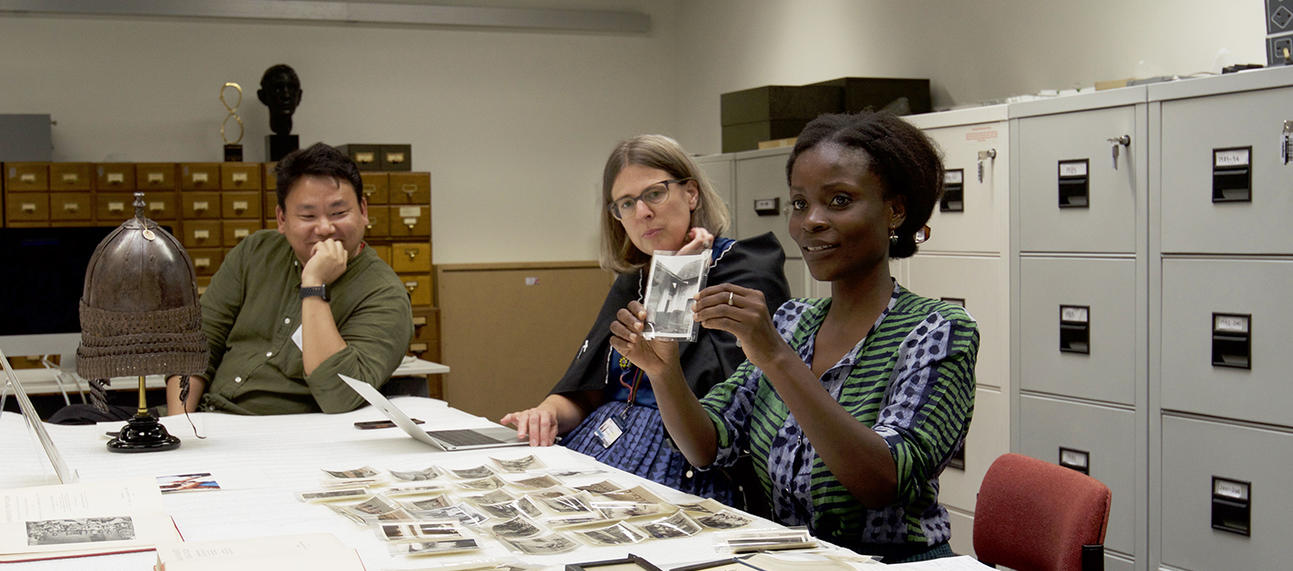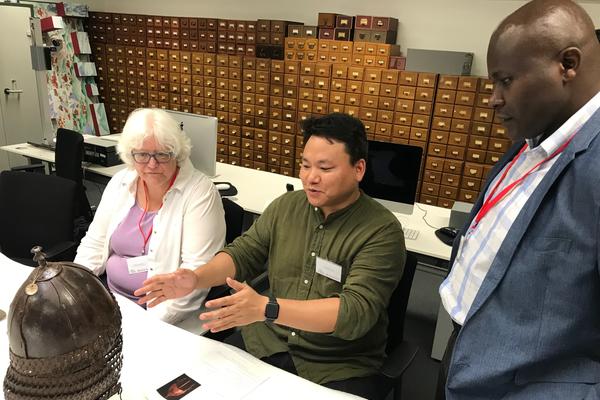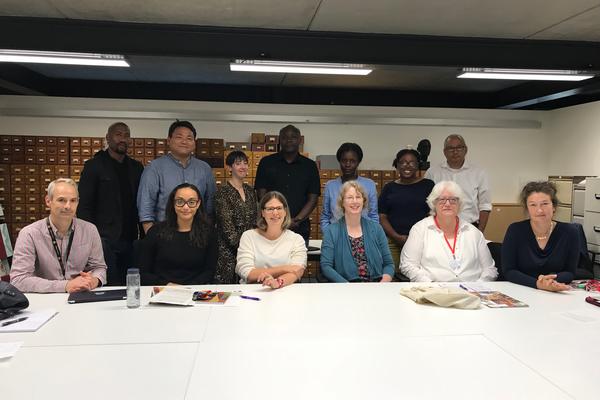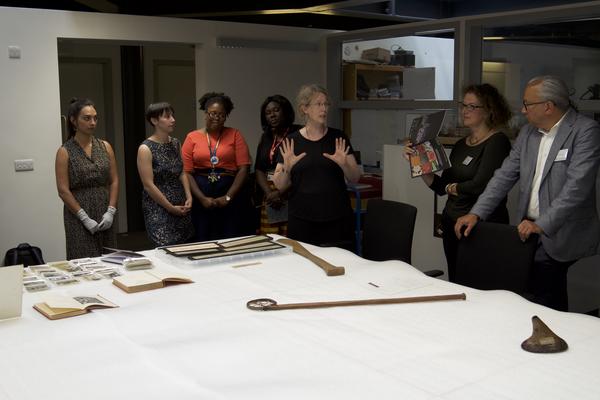Ethnographic museums and the shapes of radical hope and reconciliation
Ethnographic Museums and the shapes of radical hope and reconciliation was a Wenner-Gren Foundation workshop at the Pitt Rivers Museum, University of Oxford, July 11-14, 2019, with additional funding from The Oxford Research Centre for the Humanities (TORCH), organized by Laura Van Broekhoven and Laura Peers.
Museum anthropology is in no way theoretical for either museum practitioners or for the members of communities who engage with them. We wanted, therefore, to bring together people who have wrestled thoughtfully with museum practice from the inside, as consultants, as members of communities of origin and think together, analytically but from a standpoint of intimate knowledge of the real conditions of work in museums and our praxis. To this end, we invited leading museum practitioners known to challenge institutional structure that have created new forms of practice. We were pleased the Wenner-Gren Foundation’s funding offered us the opportunity to have such a wide-ranging set of practitioners and share the deep and broad range of experiences translating histories and cultures to public audiences and working with communities and collections.
The workshop's goals were to bring together practitioners and experts to think about forms of radical hope and reconciliation in museums that steward ethnographic collections like the Pitt Rivers Museum (PRM). For several decades, museums such as PRM have explored ways to ensure they can be of relevance to stakeholders across the globe. The PI and Co-PI, who were the organisers of the conference, over the past decades, alongside other colleagues in the field, have worked closely with Indigenous and diaspora peoples to find ways to reconnect collections and communities of origin. The development of these practices challenges all aspects of museums, but often do not sufficiently address the needs of Indigenous experts, and often remain framed within a museological praxis that, although constantly changing, can be rigid and focused on its own status quo. In this workshop we wanted to reflect on the concept of Radical Hope and bring together global thought leaders on ethnographic museums to consider how to reinvigorate museums and the ethnographic collections they steward by foregrounding indigenous knowledges and curatorial practices, and rethinking assumptions about museums. Finding ways to co-produce new knowledges and co-curate displays, are means that have been tried by many institutions, but at times the more challenging component in this work is to find ways to bridge the ontological and epistemological disconnects that surface during this work and the reluctance of museums (and institutions they sit in) to truly relinquish power, authority and ownership. Especially in these moments, Radical Hope (as developed in Lear[1]and further by Dreyfus[2]) is often accompanied by Radical Despair at the seeming immutability of handling, interpretation modes and stewardship practices.
Museums across the UK and EU hold substantial material legacies of colonial and imperial processes, and are struggling to translate theoretically-informed practice developed in countries of origin into the global remit and geographically distanced spaces of transnational museums with large global audiences. Our invited workshop wanted to bring together heritage practitioners from different geographies with UK museum professionals, to consider forms of hope, vulnerability, care and reconciliation in museums with ethnographic collections, and to consider how new theory might be developed from such praxis to better understand it and to support emerging forms of heritage interpretation and stewardship linking local and global contexts.
Proceedings
After a round of introductions, where participants shared experiences with practices of reconciliation and radical hope (and radical despair), we had a session that reflected on these practices through speaking about specific objects that participants had selected. This session allowed for reflection on a wide range of themes including the necessity for objects to be given cultural care through use and cultural guidance.
Further sessions explored existing theories and practices that could guide us as anthropologists and museum professionals engaged in transforming the institutions we work in (or with) into spaces of critical reflection and discussed whether beneficial engagement with historic legacies of collecting is actually possible. Emerging practices and theories focused on self-representation and cultural care. Theoretical reflections focused on aspects of new-materialisms theory that articulates and helps us to understand the shapes of reconciliation and hope for historic ethnographic collections, and discussion around ownership and repatriation and how objects can only be understood in relationship to the people that were their makers, users, interpreters, carers and in relationship to the materials and resources they are made of.
Guidance was given around what aspects of practices PRM might consider changing. PRM staff led delegates on a tour of the PRM and a discussion of the Museum’s efforts to work with communities of origin, asking: how does this historic, very specific museum allow for work that is informed by radical hope? The Saturday afternoon session addressed lessons learned that we can share. We asked each participant to describe his or her work in relation to the themes of the symposium and asked each one: What were radical hope initiatives that you undertook, but that possibly didn’t work out as you had hoped, but even then, were still hopeful?
Saturday evening, we organised a public panel discussion which attracted 35 external participants including members of the museum profession who travelled from Scotland, London and Brighton.
Overall reflections on Sunday morning raised a broad range of issues that ranged from hypervisible initiatives to self-reflexivity about privilege and authority and how words can create confusion and delays, for example when exhibiting nationalism and heroism. On Sunday morning participants reflected on their impressions of PRM and whether they saw possibilities to implement some practices of hope in its Victorian-seeming displays. Joyce suggested that it had been noticeable, during the staff-guided tour of the Museum, that issues related to coloniality (the density of the objects; lack of plurivocality in the galleries; lack of addressing empire and telling of the truth about colonial violence) so far had been addressed mostly through adding labels or the interpretations on labels. This asked the question: How much can labelling really do? Should the main response continue to be labelling? Or, as Marenka suggested about the Benin Bronzes, might we better consider telling the story by different assemblages of objects, such as commissioned works that engage with more problematic sides of the story?
Discussion was passionate and animated in the final sessions on Sunday where participants agreed they would like to reflect on what they felt the Museum should take forward as practices of Radical Hope and Reconciliation. We asked participants to sum up their key messages from the workshop and share point-form post-it notes (see attached), and speak to the group on overarching ideas and points of learning from across the sessions. Aspects that were touched upon included the spiritual wellbeing of objects, questions on museo-facting donations, and the limitations of labelling and dangers of assuming the historical documentation that comes with objects is correct; the dangers of using a language of innocence for describing violent acts of taking and ‘exploring’ instead of more historically accurate descriptions of military violence (more concrete examples are given in the appendix) and a true engagement with questions of ownership and repatriation of objects.
Participants
Nana Oforiatta Ayim: Director of ANO and Ghanian cultural historian, curator and filmmaker
Joe Horse Capture, Director of Native American Initiatives at the Minnesota Historical Society, USA
Rosemary Joyce, University of California, Berkeley, USA
Wycliffe Oloo Omondi, Researcher and Curator with the Directorate of Antiquities, Sites and Monuments at National Museums of Kenya
Damion Thomas, Curator of Sports, National Museum of African American History & Culture, Smithsonian Institution, USA
Christo Kefalas, Curator of World Cultures, The National Trust
Sara Wajid MBE, Head of Engagement, Museum of London and co- founder of Museum Detox, a network of BAME museum workers
Thupten Kelsang, Tibetan doctoral student at Oxford University
Marina De Alarcon, Joint Head of Collections and Repatriation Officer Pitt Rivers Museum
Laura Peers, Curator Emerita and Research Affiliate, Pitt Rivers Museum
Laura Van Broekhoven, Director, Pitt Rivers Museum
Marenka Thompson-Odlum, Research Assistant Labelling Matters project, Pitt Rivers Museum
Beth McDougall, Families and Communities Officer, Pitt Rivers Museum
Christopher Morton, Head of Research & Curator of Photographs and Manuscripts
Summary of outcomes
Our introductory remarks noted that while we are all keenly aware of entrenched relations of power and difficult histories associated with ethnographic collections, our practice is a practice that balances between hope and sometimes despair but a practice aimed at reconciliation. We do what we do in hope of creating new narratives about the past, about the collections we steward, that will affect how people think and how they treat each other in the present but function within institutions that at times seem unmoveable and vestiges of colonialism that require change that is so systemically different, that it might in fact be impossible within the walls of museums to effect it (which is why we did not limit our conversation to the possibilities that exist within current practices).
In Canada, the Truth and Reconciliation Commission, which examined issues about Indigenous relations with settler society past and present, defined reconciliation as “establishing and maintaining a mutually respectful relationship between Aboriginal and non-Aboriginal peoples in this country. In order for that to happen, there has to be awareness of the past, an acknowledgement of the harm that has been inflicted, atonement for the causes, and action to change behaviour.” Such thinking is underscored by the writing of prominent indigenous scholars and is behind our collective practice of decoloniality in museums, considering practices and processes of indigenisation, resistance and refusal, re-existence (Adolfo Alban Achinte), resurgence (eg. Leanne Betasamosake Simpson) to recognise the need for an approach that centres pluriversality and work towards increased pluri-vocality of narratives and diversity in staff and visitors composition.
Joe Horse Capture touched on the need for re-introducing use of historical objects as part of the spiritual wellbeing of objects such as a Great Lake Lacrosse Stick. Horse Capture illustrated how the MHS, in their development of an exhibition on Lacrosse for 2020 was using the opportunity of developing work with community members and practitioners of Lacrosse to use the collection not just to connect with the community but also for revival of practices of making and playing. How the work that they had done also illustrated that many of the aspects that are touched on and the contextual practicalities often illustrate larger issues such as the loss of biodiversity and habitat and planetary precarities and how cultural practices of making and playing also depend on the continued availability of natural resources.
Christo Kefalas from the National Trust touched on the difficulties of truly supporting community work and providing cultural care when the collections (in this case of Maori communities) are held so far from the people who would provide cultural care. Damion Thomas, from the NMAAHC considered a Sudanese arm band and the limitation of labels in practices of meaning-giving, nuance and specificities. While all fighting styles are both localised and rooted in interconnectivity labels will often reduce objects to essentialized characteristics that do not aide deeper understanding but impede it. Working with practitioners in NMAAHC and descendants of important sports figures, helped contextualise and activate more multiple stories.
Laura Peers and Marina de Alarcon shared an experience around smudging materials that were donated to the Museum during a Blackfoot visit. Sweetgrass is used as a way to protect and communicate with ancestors and how they struggled with the question of accessioning the object, and the decision whether to put it on display. Laura Van Broekhoven, illustrated through a Maasai ceremonial coat, given by Maasai representatives when they visited in 2018, continued with the question whether to further museo-fact objects of reconciliation like this one, or not. If the latter, like in the case of the sweetgrass, and we do not accession it, what hierarchies of object categories would that imply? And, how would that sit comfortably with other collections, many of which we don’t know the pedigrees of or we know were taken without consent and should be considering to return therefore. Isn’t it exactly these sorts of objects such as the cloak and the sweetgrass—given consciously, purposefully, as self-representational items—that we should be acquisitioning and displaying, thereby altering the assemblages and the stories told.
Rosemary Joyce touched on the erroneous contentious and problematic assumptions that often underlie labelling in museum and the hopeful possibilities of reinterpreting these archives of objects as a tool in the fight for sovereignty and land rights of indigenous peoples in particular as an illustration of a denied existence. Reflecting on a Pech object that was labelled as ‘Maya’ she called out how museums, by doing that uncritically become accomplices to the violence and injustice that Indigenous Peoples suffer, especially those, like the Pech, that are denied their very existence by the Nation States they now form part of. It is important to resist the presumed innocence of naming and ensure research leads to changes in databases and elsewhere so that these sorts of objects can be of use in the fight of Indigenous Peoples in their rights for existence: material presence of objects that are made by their ancestors, proves their existence and helps indigenous resistance and persistence.
Thupten and Nana further reflected on the problematic aspects of the presumed innocence of naming and labelling and the use of the word ‘expedition’ eg. for what were clearly military campaigns that were accompanied with violence: collections that were made during ‘expeditions’ that were effectively military invasions where massive machine guns were used to come and occupy Tibet. At the same time -in particular for peoples like Tibet- having been denied their existence, land rights and sovereignty.
Main Experiences Shared
-
-
path of radical hope: focus on process rather than cursory outcomes or outputs; long-term, cumulative approaches
-
moving beyond specificities of context (communities/region to collate a cohesive and multivocal strategy
-
indigenous museology as a mainstream field rather than special interventions for special museums
-
there can be hope at the moment of expected forms/practices of museums
-
radical forms of hope are hard work and we need to care for ourselves while doing this
-
radical hope does not always lead to change
-
imperial, colonial and settler society politics behind collections need to surface and be addressed
-
the living nature of things as persons, connected to people as possessions needs to be activated
-
contemporary cultural production needs to be valued and made possible in museum spaces with museum collections not intended for such continuing liveliness
-
the psychological and emotional effects of museum engagements require more attention, may be more transformative, may require space for grief/recovery
-
potentially, everything should be available for return
-
make public and social organisations part of the process
-
things need to be played, used, set in motion again
-
telling more stories that allow engagement through the objects
-
listening to the voices of where the objects come from
-
using the collections as interfaces for cultural revitalization
-

[1]Lear, Jonathan (2006) Radical Hope. Ethics in the Face of Cultural Devastation. Cambridge: Harvard University Press.
[2]Dreyfus, Hubert L (2009) Comments on Jonathan Lear's Radical Hope. In Philosophical Studies: An International Journal for Philosophy in the Analytic Tradition. Vol. 144, No. 1, pp. 63-70.
https://player.vimeo.com/video/363813145?color=9F7B47&portrait=0






